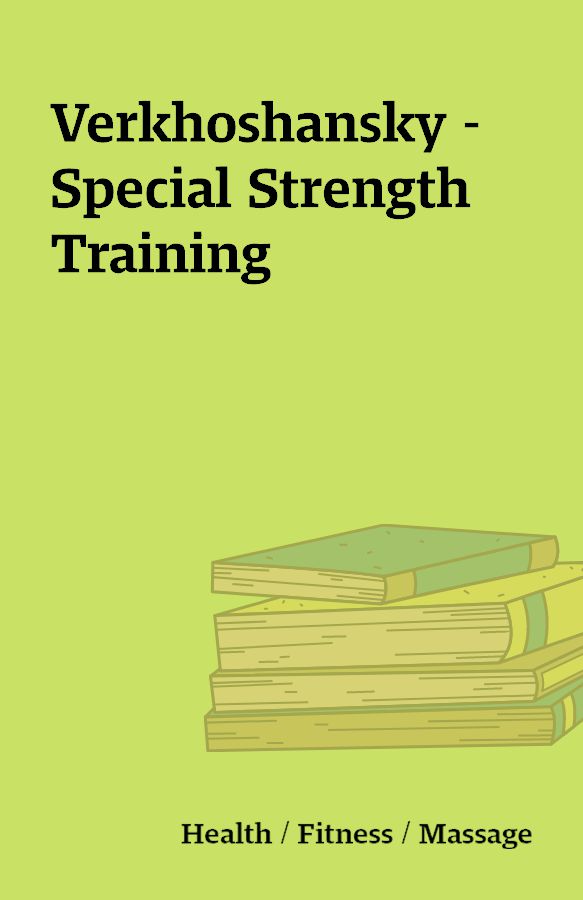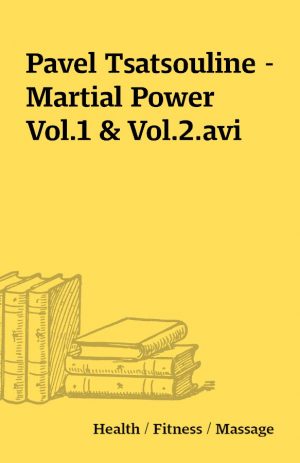Verkhoshansky – Special Strength Training
Verkhoshansky_Special_Strength_Training.pdf
[1 eBook – PDF]
Description
Special Strength Training: A Practical Manual for Coaches by Dr. Yuri V. Verkhoshansky, translated by Dr. Michael Yessis 2006Contents1. Methodological Foundations of Special Strength Training1.1 Role of SST in the Training Process1.2 The Main Emphasis of SST1.3 The Purpose of SST in the Training Process1.4 SST and qualifications of the Coach1.5 SST and the Coach’s Qualifications1.6 Strength Abilities of the Athlete1.7 Specificity of Strength Abilities1.8 The Means of SST1.9 Principles of Selecting SST Means1.10 Ways of Intensifying Motor [Muscular] Work1.11 Ways of Intensifying the Muscle Work Regime1.12 The Main Features of the SST Methodology1.13 Ways of Performing Strength Exercises1.14 Special Methods of SST2. Special Strength Training in Speed Strength Sports2.1 Development of Maximal Strength2.1.2 Exercises with Loads (Weights)2.1.2 Isometric Exercises2.2 Development of Explosive Strength and Reactive Ability2.2.1 Exercises with Loads (Weights)2.2.2 Isometric Exercises2.2.3 Shock Method2.2.4. Jump Exercises2.2.5. Complex Method2.3. Development of High-Speed Strength2.3.1 Exercises with Loads2.3.2 Alternative (Contrast) Method2.3.3 Jump Exercises2.3.4 Complex Method3. Special Strength Training in Cyclic Sports3.1. Development of Maximum Strength3.1.1. Exercises with Weights3.1.2 Isometric Exercises3.2 Development of Explosive and High-Speed Strength3.2.1 Exercises with Weights3.2.2 Jump Exercises3.3. Development of Reactive Ability3.4. Development of Local Muscular Endurance3.4.1. Exercises with Resistance (Weights)3.4.2. Jump Exercises3.4.3 Uphill Running3.4.4. Execution of the Competitive Exercise in More Difficult Conditions3.5 Development of Maximum Anaerobic Power4. Special Strength Training in Sports Having Variable Motor Regimes4.1. Strength-Aerobic Method4.2. Jump Method4.3. Circuit Method4.4. Coupling (Conjugate) Method5. The Role of Placement of SST in the Yearly Cycle5.1. Functions of SST in the Yearly Cycle5.2. Selection and Organization of SST Means5.3. System of SST Means5.4 Forms of Organization of SST5.5 Characteristics of the Concentrated Form of SST5.6 Organization of the Concentrated Strength Load “Block”5.7 Contents of the Strength Block in Various Sports5.8 Placement of SST in the Yearly Cycle5.9 Principles of SST5.9.1 The Principle of Dynamic Correspondence of the SST Means to the Motor [Movement] Structure of the Competitive Exercise5.9.2 The Principle of Specificity of SST Means5.9.3 The Principle of SST Load Concentration5.9.4 The System Principle of SST5.9.5 The Principle of Super Imposing SST Loads Having Various Training Influences5.9.6 The Priority Principle of SST in the Year Round Training System5.10 Methodological Aims to Resolve the Tasks of SST6. Training Programs6.1 Universal Program for Development of Jump Force in the Preparatory Stage of the Yearly Training Cycle6.2 Program for Perfecting Starting Acceleration Speed of Sprinters6.3 Program for Top Level Middle Distance Runners6.4 Program for Top Level Rowers6.5. Program for Development of Jump Force for Volleyball Players6.6 Special Strength Training Program for Basketball Players6.7 Program for High Level American Football Players6.8 Program for High Level Tennis Players7. ConclusionsReferences
You must be logged in to post a review.






Reviews
There are no reviews yet.